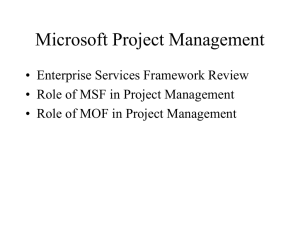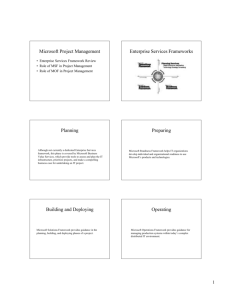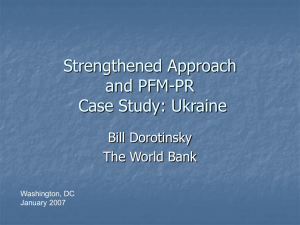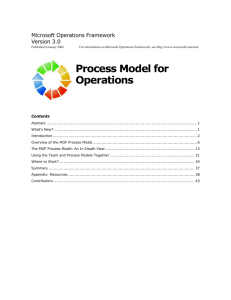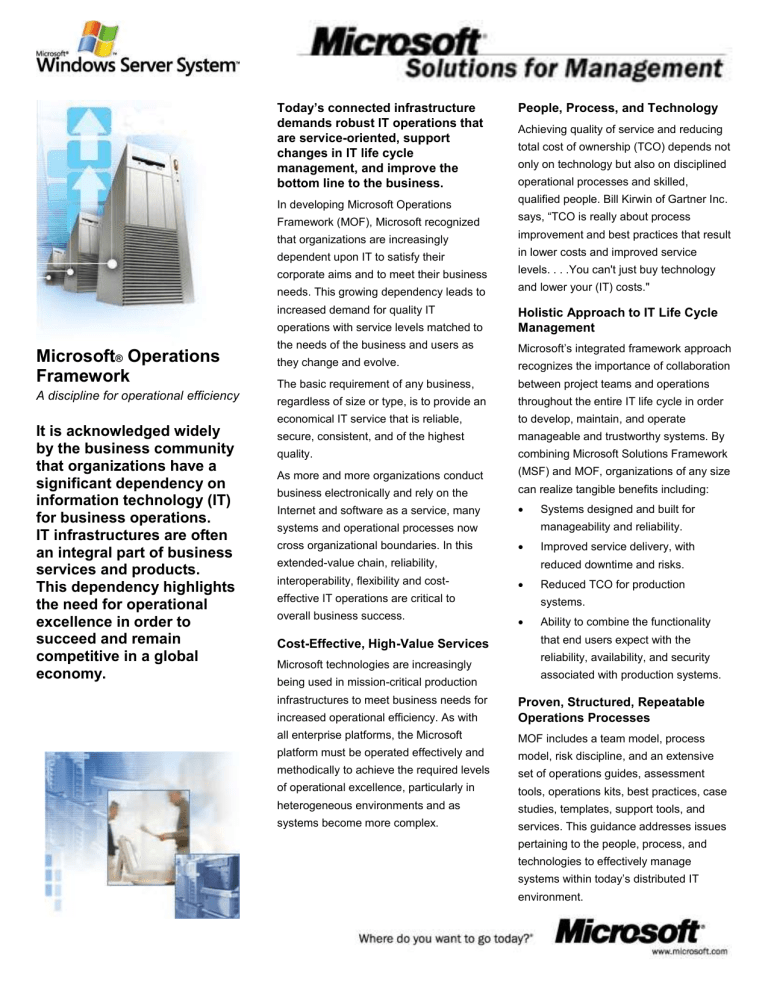
Microsoft® Operations
Framework
A discipline for operational efficiency
It is acknowledged widely
by the business community
that organizations have a
significant dependency on
information technology (IT)
for business operations.
IT infrastructures are often
an integral part of business
services and products.
This dependency highlights
the need for operational
excellence in order to
succeed and remain
competitive in a global
economy.
Today’s connected infrastructure
demands robust IT operations that
are service-oriented, support
changes in IT life cycle
management, and improve the
bottom line to the business.
People, Process, and Technology
In developing Microsoft Operations
qualified people. Bill Kirwin of Gartner Inc.
Achieving quality of service and reducing
total cost of ownership (TCO) depends not
only on technology but also on disciplined
operational processes and skilled,
Framework (MOF), Microsoft recognized
says, “TCO is really about process
that organizations are increasingly
improvement and best practices that result
dependent upon IT to satisfy their
in lower costs and improved service
corporate aims and to meet their business
levels. . . .You can't just buy technology
needs. This growing dependency leads to
and lower your (IT) costs."
increased demand for quality IT
operations with service levels matched to
Holistic Approach to IT Life Cycle
Management
the needs of the business and users as
Microsoft’s integrated framework approach
they change and evolve.
recognizes the importance of collaboration
The basic requirement of any business,
between project teams and operations
regardless of size or type, is to provide an
throughout the entire IT life cycle in order
economical IT service that is reliable,
to develop, maintain, and operate
secure, consistent, and of the highest
manageable and trustworthy systems. By
quality.
combining Microsoft Solutions Framework
As more and more organizations conduct
(MSF) and MOF, organizations of any size
business electronically and rely on the
can realize tangible benefits including:
Internet and software as a service, many
manageability and reliability.
systems and operational processes now
cross organizational boundaries. In this
extended-value chain, reliability,
interoperability, flexibility and cost-
Cost-Effective, High-Value Services
Microsoft technologies are increasingly
being used in mission-critical production
infrastructures to meet business needs for
Improved service delivery, with
reduced downtime and risks.
effective IT operations are critical to
overall business success.
Systems designed and built for
Reduced TCO for production
systems.
Ability to combine the functionality
that end users expect with the
reliability, availability, and security
associated with production systems.
increased operational efficiency. As with
Proven, Structured, Repeatable
Operations Processes
all enterprise platforms, the Microsoft
MOF includes a team model, process
platform must be operated effectively and
model, risk discipline, and an extensive
methodically to achieve the required levels
set of operations guides, assessment
of operational excellence, particularly in
tools, operations kits, best practices, case
heterogeneous environments and as
studies, templates, support tools, and
systems become more complex.
services. This guidance addresses issues
pertaining to the people, process, and
technologies to effectively manage
systems within today’s distributed IT
environment.
Leveraging Industry and Microsoft
Best Practices
Effective Operations Teams Driven
by Quality Goals
Proactive Risk Management
ITIL (the IT Infrastructure Library) is the
The MOF Team Model organizes
fundamental to both MOF and MSF.
most widely accepted approach to IT
communication, skills, roles, and
Because IT plays such a crucial role in the
service management in the world. It
responsibilities into a highly competent
way organizations do business today, it is
provides a comprehensive and consistent
and flexible operations staffing model of
increasingly important that they create
set of best practices for IT service
small teams of peers rather than a
consistent and workable processes to
management, promoting a quality
traditional top-down linear structure. Key
cover all decisions on risks involving IT.
approach to achieving business
quality goals that drive the model are:
The MOF Risk Management Discipline
effectiveness and efficiency in the use of
Appropriately controlled release and
provides guidelines and suggestions on
information systems. ITIL is based on the
change management, and accurate
how IT operations can adopt a “risk
collective experience of commercial and
inventory tracking.
management culture” at all levels. This
Management of physical
approach emphasizes the importance of
environments and infrastructure tools,
managing risk as part of each person’s
balancing cost with technology and
daily activities. The goal of creating a risk
business needs.
culture is to move to a situation where
Quality customer support, quick
staff and managers instinctively look for
problem resolution, and dedicated
and consider risks as well as rewards
service level management ownership.
when making IT operational decisions.
Predictable, repeatable, and
Want to Know More?
governmental practitioners worldwide.
This has been distilled into one reliable,
coherent approach, which is becoming a
standard used by some of the world's
leading businesses. MOF combines these
standards with specific guidelines for
using Microsoft products and
technologies. In addition, MOF extends
the ITIL code of practice to support
automated day-to-day system and
distributed environments and current
service management.
industry trends such as application hosting
and Web-based transactional systems.
Continuous Assessment and
Adaptation of Operations Services
Carefully protected corporate assets.
Dedicated management of external
Risk Management is a discipline that is
For more information about MOF concepts
and principles, see the MOF white papers
at http://www.microsoft.com/mof.
support and services.
MOF is based on a set of principles and
models that make up the core elements of
the framework. The MOF Process Model
promotes a high level of availability,
reliability, and manageability. Managers
will find the MOF process model useful in:
Production
Production certification
User acceptance
Prerelease
Staging and integration
System test environments
Key to the model is that operations, like
software development, has a life cycle
made up of distinct phases that run
concurrently.
© 2004 Microsoft Corporation. All rights reserved.
This data sheet is for informational purposes only. MICROSOFT MAKES NO WARRANTIES, EXPRESS OR IMPLIED, IN THIS SUMMARY.
Microsoft and Windows Server System are either registered trademarks or trademarks of Microsoft Corporation in the United States and/or other countries. The names of actual companies and
products mentioned herein may be the trademarks of their respective owners.
Microsoft Corporation One Microsoft Way Redmond, WA 98052-6399 USA


